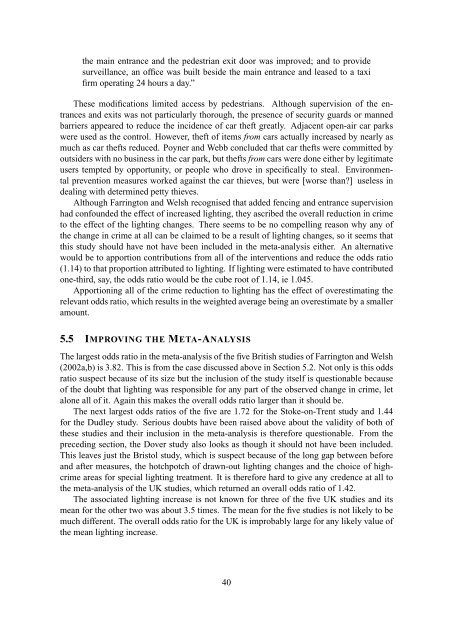outdoor lighting and crime, part 1 - Astronomical Society of Victoria
outdoor lighting and crime, part 1 - Astronomical Society of Victoria
outdoor lighting and crime, part 1 - Astronomical Society of Victoria
Create successful ePaper yourself
Turn your PDF publications into a flip-book with our unique Google optimized e-Paper software.
the main entrance <strong>and</strong> the pedestrian exit door was improved; <strong>and</strong> to provide<br />
surveillance, an <strong>of</strong>fice was built beside the main entrance <strong>and</strong> leased to a taxi<br />
firm operating 24 hours a day.”<br />
These modifications limited access by pedestrians. Although supervision <strong>of</strong> the entrances<br />
<strong>and</strong> exits was not <strong>part</strong>icularly thorough, the presence <strong>of</strong> security guards or manned<br />
barriers appeared to reduce the incidence <strong>of</strong> car theft greatly. Adjacent open-air car parks<br />
were used as the control. However, theft <strong>of</strong> items from cars actually increased by nearly as<br />
much as car thefts reduced. Poyner <strong>and</strong> Webb concluded that car thefts were committed by<br />
outsiders with no business in the car park, but thefts from cars were done either by legitimate<br />
users tempted by opportunity, or people who drove in specifically to steal. Environmental<br />
prevention measures worked against the car thieves, but were [worse than?] useless in<br />
dealing with determined petty thieves.<br />
Although Farrington <strong>and</strong> Welsh recognised that added fencing <strong>and</strong> entrance supervision<br />
had confounded the effect <strong>of</strong> increased <strong>lighting</strong>, they ascribed the overall reduction in <strong>crime</strong><br />
to the effect <strong>of</strong> the <strong>lighting</strong> changes. There seems to be no compelling reason why any <strong>of</strong><br />
the change in <strong>crime</strong> at all can be claimed to be a result <strong>of</strong> <strong>lighting</strong> changes, so it seems that<br />
this study should have not have been included in the meta-analysis either. An alternative<br />
would be to apportion contributions from all <strong>of</strong> the interventions <strong>and</strong> reduce the odds ratio<br />
(1.14) to that proportion attributed to <strong>lighting</strong>. If <strong>lighting</strong> were estimated to have contributed<br />
one-third, say, the odds ratio would be the cube root <strong>of</strong> 1.14, ie 1.045.<br />
Apportioning all <strong>of</strong> the <strong>crime</strong> reduction to <strong>lighting</strong> has the effect <strong>of</strong> overestimating the<br />
relevant odds ratio, which results in the weighted average being an overestimate by a smaller<br />
amount.<br />
5.5 IMPROVING THE META-ANALYSIS<br />
The largest odds ratio in the meta-analysis <strong>of</strong> the five British studies <strong>of</strong> Farrington <strong>and</strong> Welsh<br />
(2002a,b) is 3.82. This is from the case discussed above in Section 5.2. Not only is this odds<br />
ratio suspect because <strong>of</strong> its size but the inclusion <strong>of</strong> the study itself is questionable because<br />
<strong>of</strong> the doubt that <strong>lighting</strong> was responsible for any <strong>part</strong> <strong>of</strong> the observed change in <strong>crime</strong>, let<br />
alone all <strong>of</strong> it. Again this makes the overall odds ratio larger than it should be.<br />
The next largest odds ratios <strong>of</strong> the five are 1.72 for the Stoke-on-Trent study <strong>and</strong> 1.44<br />
for the Dudley study. Serious doubts have been raised above about the validity <strong>of</strong> both <strong>of</strong><br />
these studies <strong>and</strong> their inclusion in the meta-analysis is therefore questionable. From the<br />
preceding section, the Dover study also looks as though it should not have been included.<br />
This leaves just the Bristol study, which is suspect because <strong>of</strong> the long gap between before<br />
<strong>and</strong> after measures, the hotchpotch <strong>of</strong> drawn-out <strong>lighting</strong> changes <strong>and</strong> the choice <strong>of</strong> high<strong>crime</strong><br />
areas for special <strong>lighting</strong> treatment. It is therefore hard to give any credence at all to<br />
the meta-analysis <strong>of</strong> the UK studies, which returned an overall odds ratio <strong>of</strong> 1.42.<br />
The associated <strong>lighting</strong> increase is not known for three <strong>of</strong> the five UK studies <strong>and</strong> its<br />
mean for the other two was about 3.5 times. The mean for the five studies is not likely to be<br />
much different. The overall odds ratio for the UK is improbably large for any likely value <strong>of</strong><br />
the mean <strong>lighting</strong> increase.<br />
40
















